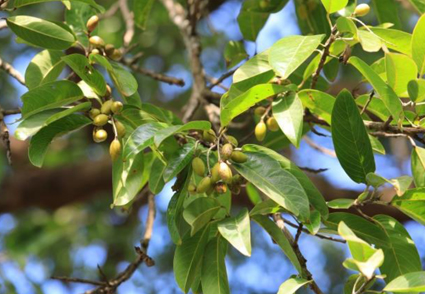Abstract
Bhesa xieii, a new species of Centroplacaceae from southern China, is described and illustrated. Morphological comparison with Bhesa robusta, B. paniculata and B. ceylanica is provided. Both morphological and molecular evidences clearly indicate that B. xieii is a distinct species. It differs in capsules narrowly ovate, ca. 3 cm long, apex obtuse, peduncle thick, ca. 3 mm long; racemes; flowers pale yellow, pedicels 1.5–2.5 mm long; calyx lobes broadly ovate to subrotundate, apex obtuse; petals ovate to oblong-elliptic, apex obtuse, inflexed; lamina oblong-elliptic to narrowly ovate, base obtuse or subtruncate, apex acute or obtuse.
References
<p>An, J.C., Zhang, Z.Y. & Huang, M.P. (2017) Genetic Relationship of Three Individuals of <em>Bhesa sinica</em> by RAPD. <em>Guangxi Forestry Science</em> 46 (4): 406–408.</p>
<p>APG III (2009) An update of the Angiosperm Phylogeny Group classification for the orders and families of flowering plants. APG III. <em>Botanical Journal of the Linnean Society</em> 161: 105–121. https://doi.org/10.1111/j.1095-8339.2009.00996.x</p>
<p>APG IV (2016) An update of the Angiosperm Phylogeny Group classification for the orders and families of flowering plants: APG IV. <em>Botanical Journal of the Linnean Society</em> 181: 1–20. https://doi.org/10.1111/boj.12385</p>
<p>Arnott, G.A.W. (1834) Characters of three genera of Indian plants. <em>Edinburgh New Philosophical Journal </em>16: 314-316.</p>
<p>Capella-Gutierrez, S., Silla-Martinez, J.M. & Gabaldon, T. (2009) TrimAl: a tool for automated alignment trimming in large-scale phylogenetic analyses. <em>Bioinformatics</em> 25 (15): 1972–1973. https://doi.org/10.1093/bioinformatics/btp348</p>
<p>Ma, J.S. (2008) <em>Bhesa</em> Buchanan-Hamilton ex Arnott. <em>In</em>: Wu, Z.Y., Raven, P.H. & Hong, D.Y. (eds.) <em>Flora of China</em>, Vol. 11. Science Press, Beijing & Missouri Botanical Garden Press, St. Louis, pp. 479.</p>
<p>Hou, D. (1958) A conspectus of the genus <em>Bhesa</em> (Celastraceae). <em>Blumea.</em> Suppl. 4 (1): 149–153.</p>
<p>Jin, J.J., Yu, W.B., Yang, J.B., Song, Y., dePamphilis, C.W., Yi, T.S. & Li, D.Z. (2020) GetOrganelle: a fast and versatile toolkit for accurate de novo assembly of organelle genomes.<em> Genome Biology</em> 21: 241. https://doi.org/10.1186/s13059-020-02154-5</p>
<p>Kalyaanamoorthy, S., Minh, B.Q., Wong, T.K.F., von Haeseler, A. & Jermiin, L.S. (2017) ModelFinder: Fast model selection for accurate phylogenetic estimates. <em>Nature Methods</em> 14: 587–589. https://doi.org/10.1038/nmeth.4285</p>
<p>Katoh, K. & Standley, D.M. (2013) MAFFT multiple sequence alignment software version 7: Improvements in performance and usability. <em>Molecular Biology and Evolution</em> 30: 772–780. https://doi.org/10.1093/molbev/mst010</p>
<p>Nguyen, L.T., Schmidt, H.A., von Haeseler, A. & Minh, B.Q. (2014) IQ−TREE: A fast and effective stochastic algorithm for estimating maximum−likelihood phylogenies. <em>Molecular Biology and Evolution </em>32: 268–274. https://doi.org/10.1093/molbev/msu300</p>
<p>Tillich, M., Lehwark, P., Pellizzer, T., Ulbricht-Jones, E.S., Fischer, A., Bock, R. & Greiner, S. (2017) GeSeq – versatile and accurate annotation of organelle genomes. <em>Nucleic Acids Research </em>45: W6–W11. https://doi.org/10.1093/nar/gkx391</p>
<p>Wick, R.R., Schultz, M.B., Zobel, J. & Holt, K.E. (2015) Bandage: interactive visualization of de novo genome assemblies. <em>Bioinformatics</em> 31: 3350–3352. https://doi.org/10.1093/bioinformatics/btv383</p>
<p>William, R. (1824) <em>Flora Indica</em> 2. Printed at the Mission Press, Serampore, pp. 395.</p>
<p>APG III (2009) An update of the Angiosperm Phylogeny Group classification for the orders and families of flowering plants. APG III. <em>Botanical Journal of the Linnean Society</em> 161: 105–121. https://doi.org/10.1111/j.1095-8339.2009.00996.x</p>
<p>APG IV (2016) An update of the Angiosperm Phylogeny Group classification for the orders and families of flowering plants: APG IV. <em>Botanical Journal of the Linnean Society</em> 181: 1–20. https://doi.org/10.1111/boj.12385</p>
<p>Arnott, G.A.W. (1834) Characters of three genera of Indian plants. <em>Edinburgh New Philosophical Journal </em>16: 314-316.</p>
<p>Capella-Gutierrez, S., Silla-Martinez, J.M. & Gabaldon, T. (2009) TrimAl: a tool for automated alignment trimming in large-scale phylogenetic analyses. <em>Bioinformatics</em> 25 (15): 1972–1973. https://doi.org/10.1093/bioinformatics/btp348</p>
<p>Ma, J.S. (2008) <em>Bhesa</em> Buchanan-Hamilton ex Arnott. <em>In</em>: Wu, Z.Y., Raven, P.H. & Hong, D.Y. (eds.) <em>Flora of China</em>, Vol. 11. Science Press, Beijing & Missouri Botanical Garden Press, St. Louis, pp. 479.</p>
<p>Hou, D. (1958) A conspectus of the genus <em>Bhesa</em> (Celastraceae). <em>Blumea.</em> Suppl. 4 (1): 149–153.</p>
<p>Jin, J.J., Yu, W.B., Yang, J.B., Song, Y., dePamphilis, C.W., Yi, T.S. & Li, D.Z. (2020) GetOrganelle: a fast and versatile toolkit for accurate de novo assembly of organelle genomes.<em> Genome Biology</em> 21: 241. https://doi.org/10.1186/s13059-020-02154-5</p>
<p>Kalyaanamoorthy, S., Minh, B.Q., Wong, T.K.F., von Haeseler, A. & Jermiin, L.S. (2017) ModelFinder: Fast model selection for accurate phylogenetic estimates. <em>Nature Methods</em> 14: 587–589. https://doi.org/10.1038/nmeth.4285</p>
<p>Katoh, K. & Standley, D.M. (2013) MAFFT multiple sequence alignment software version 7: Improvements in performance and usability. <em>Molecular Biology and Evolution</em> 30: 772–780. https://doi.org/10.1093/molbev/mst010</p>
<p>Nguyen, L.T., Schmidt, H.A., von Haeseler, A. & Minh, B.Q. (2014) IQ−TREE: A fast and effective stochastic algorithm for estimating maximum−likelihood phylogenies. <em>Molecular Biology and Evolution </em>32: 268–274. https://doi.org/10.1093/molbev/msu300</p>
<p>Tillich, M., Lehwark, P., Pellizzer, T., Ulbricht-Jones, E.S., Fischer, A., Bock, R. & Greiner, S. (2017) GeSeq – versatile and accurate annotation of organelle genomes. <em>Nucleic Acids Research </em>45: W6–W11. https://doi.org/10.1093/nar/gkx391</p>
<p>Wick, R.R., Schultz, M.B., Zobel, J. & Holt, K.E. (2015) Bandage: interactive visualization of de novo genome assemblies. <em>Bioinformatics</em> 31: 3350–3352. https://doi.org/10.1093/bioinformatics/btv383</p>
<p>William, R. (1824) <em>Flora Indica</em> 2. Printed at the Mission Press, Serampore, pp. 395.</p>


